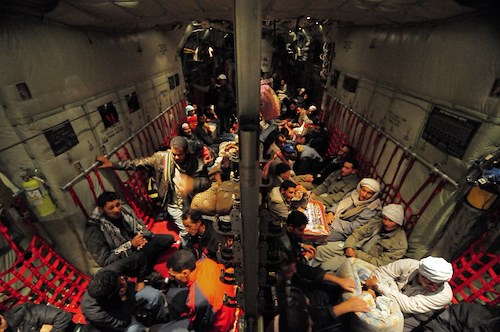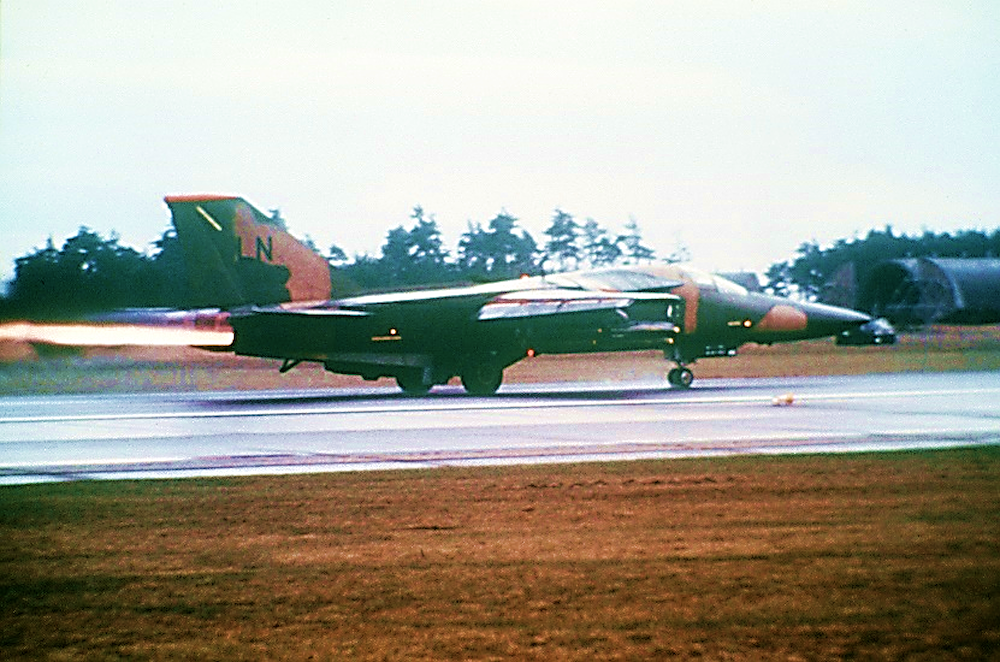December: North African Odysseys
By: Mr. William Butler, USEUCOM Command Historian

Beginning in the late 1960s, international relationships with the North African nation of Libya were strained and often difficult. This was especially the case in the aftermath of Muammar Qaddafi’s coup d’état in September 1969. After 26 years of continuous operation, Wheelus Air Base near Tripoli, which had been an important American aviation training center and transportation hub, was turned over the revolutionary government and all U.S. forces left the country by mid-June 1970. The Qaddafi regime’s subsequent standing in the world was marred by its recurrent involvement in terrorist activity, as well as alleged incidents of weapons smuggling and espionage. Countering the dictator’s efforts to disrupt peace in the region would be a consistent facet of U.S. European Command (USEUCOM) operations for several decades.
By early 1973, Qaddafi had claimed a large swath of the Gulf of Sidra as part of the country’s territorial waters and declared its closure to international air and maritime traffic. On 21 March 1973, two Libyan Mirage fighters intercepted and fired on a U.S. Air Forces in Europe (USAFE) unarmed C-130 flying through this area. Although the airlifter evaded the attack and landed safely in Greece, this incident prompted the U.S. to begin Freedom of Navigation (FON) operations in the gulf as Qaddafi’s claim did not meet the criteria for territorial waters established by international law. Naval Forces Europe (NAVEUR) and its Sixth Fleet were tasked with undertaking frequent FON missions in subsequent years. American carriers provided escort for others and flew air patrols over the gulf. Libyan interceptors often confronted Sixth Fleet vessels and aircraft which intensified by late 1980.
In response, American President Ronald Reagan later directed a larger display of naval force led by a pair of aircraft carriers, the U.S.S. Forrestal and U.S.S. Nimitz. They deployed to the disputed area in mid-summer 1981 and conducted additional patrols and exercises in the gulf. During a training event on 19 August, fighters from the Nimitz were fired on by Libyan Su-22s, two of which were subsequently shot down by American F-14s. While no additional encounters of this type occurred in the immediate aftermath, the incident stoked further animosity between the two countries that would lead to a much larger confrontation a few years later.
Tensions with Libya rapidly escalated after the hijacking of an American civilian airliner in June 1985, and subsequent terrorist attacks at the Rome and Vienna airports in late December that same year. In January 1986, the U.S. formally broke off diplomatic relations with Qaddafi’s government in protest over his regime’s involvement. The Sixth Fleet increased its FON operations with additional carriers forming a much larger battle group in the gulf. In March, the American fleet retaliated with air strikes after Libyan forces launched surface-to-air missiles at American patrol aircraft. On 2 April 1986, the American government blamed Libya for the deaths of four people who were killed when a bomb exploded on another civilian airliner over Argos, Greece. Finally, terrorists bombed the La Belle Discotheque in West Berlin on 5 April, killing two U.S. soldiers and wounding more than 230 others, including 50 Americans. President Reagan promptly noted "exact, precise, and irrefutable" evidence of Libyan involvement and directed a retaliatory action known as Operation ELDORADO CANYON.

Following the end of the Cold War, the U.S. became focused on operations in the Middle East as attention was shifting to another dictatorial regime in Iraq. In the European theater, USEUCOM became deeply engaged in a series of operations in the turbulent Balkans region, but all the while, it kept a wary eye on the Qaddafi regime. The beginning of the Global War on Terror in 2001 brought about a new emphasis on countering the actions of terrorist organizations. During this period, Qaddafi remained in power despite an extensive series of United Nations (UN) sanctions for the country’s terrorist activities in the decades prior. His repressive regime attempted to normalize relationships with the U.S. and Europe in the early 2000s. These efforts only masked underlying problems within the country, which resulted in another series of operations just ten years ago.
Early 2011 witnessed a swell of revolt across North Africa and the Middle East. Large scale protests in Tunisia and Egypt led to the resignations of their respective presidents and similar unrest quickly rippled through other nations in the region. Following on the heels of the fall of the Mubarak government in neighboring Egypt, mid-February protests in the eastern Libyan city of Benghazi led to fiery clashes with pro-government groups and riot police. Qaddafi‘s brutal retaliation against opposition elements prompted the UN to impose severe penalties against his regime. By early March, the U.S., Great Britain, France, and others sought to take a more direct role in support of the Libyan people.
In one of the first actions, American President Barack Obama publicly outlined on 3 March 2011 his approval of military assistance to a broader U.S. government initiative providing humanitarian relief for those fleeing the fighting. As the combatant command responsible for military operations on the African continent since 2008, U.S. Africa Command (USAFRICOM) stood up Joint Task Force-ODYSSEY DAWN (JTF-OD) under the leadership of Admiral Samuel Locklear III, the NAVEUR commander serving in a multi-hatted role for both European and African theaters. Initially, JTF-OD’s mission was to provide humanitarian assistance and conduct the evacuation of U.S. citizens and other foreign nationals from Libya. The operation would rely heavily on USEUCOM forces, and as with NAVEUR, USAFE also assisted in a multirole capacity.
As the situation in Libya deteriorated and Qaddafi continued his vicious campaign against an ever growing number of opposition groups, the UN took the next step in international efforts to resolve the crisis on 17 March by imposing a no-fly zone over the country through Security Council Resolution 1973. Two days later, President Obama authorized offensive operations by U.S. forces as part of a larger coalition with Great Britain, France, and others to implement the no-fly zone over Libya and protect Libyan civilians. With this new more extensive mission, JTF-OD pursued a coalition air campaign to end the violence against civilians in the country.
While operations against the regime started as an American-led coalition, the North Atlantic Treaty Organization (NATO) had agreed earlier in March to take steps to support the UN resolutions as well. Initially, NATO began air surveillance and naval monitoring as part of the arms embargo placed upon Libyan territory. Later, the alliance adopted the direct embargo interdiction effort on 23 March, only a few days after the initial ODYSSEY DAWN air strikes. This mission was designated Operation UNIFIED PROTECTOR and grew in scope as NATO looked to widen its role in support of UN desires to bring about a resolution to the conflict. Finally on 25 March, the North Atlantic Council, NATO’s governing body, agreed to assume the no-fly zone mission and its associated task of protecting the Libyan populace. JTF-OD and coalition air strikes degrading the pro-Qaddafi forces threatening Libyan civilians continued while NATO and U.S. command elements worked out the details of mission transfer. Finally on 31 March 2011, NATO’s Allied Joint Forces Command-Naples took over responsibility for operations against Qaddafi, and the JTF-OD mission ended after just 13 days. However, the completion of ODYSSEY DAWN did not mean the end of USEUCOM participation in the Libyan mission. USAFE and NAVEUR units continued to support UNIFIED PROTECTOR until it officially ended on 31 October 2011 following Qaddafi’s death and the dismantling of his regime.
The many decades of operations in North Africa were an important part of USEUCOM’s efforts at preserving the peace across the Mediterranean region. Enduring partnerships between NAVEUR and USAFE in the earlier years, as well as with USAFRICOM and NATO in recent years were a hallmark of these activities. They remain so still today and are a testament to the command’s readiness to respond whenever and wherever needed.


